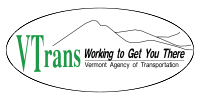Vermont Agency of Transportation
 | |
| Agency overview | |
|---|---|
| Preceding agencies |
|
| Jurisdiction | Vermont |
| Headquarters |
One National Life Drive Montpelier, Vermont |
| Agency executives |
|
| Parent agency | State of Vermont |
| Website | http://www.aot.state.vt.us |
The Vermont Agency of Transportation (VTrans) is responsible for planning, development, implementation and maintenance of a variety of transportation infrastructure. This includes roads, bridges, state-owned railroads, airports, park and ride facilities, bicycle facilities, pedestrian paths, public transportation facilities and services, and Department of Motor Vehicles operations and motor carrier enforcement. The agency was created in 1979 by combining the departments of Highway, Motor Vehicles, Aeronautics and Public Transit. Sue Minter was appointed Secretary in 2015; Chris Cole serves as Deputy Secretary. VTrans has more than 1300 employees organized in four divisions: Policy, Planning and Intermodal Development; Finance and Administration; Motor Vehicle; and Highway.
It is part of the Government of Vermont.
Responsibility
The federal government has provided most of the money to construct federal (Class I) highways but the state has the responsibility to maintain them. The state, in turn, builds state (Class II) roads and it is up to the local towns and municipalities to maintain them.[1]
Vermont highway system
History
In 2010 the paving budget for the state was $118 million which would pave 250 miles (400 km). The budget for bridges was $93.9 million. Structurally deficient bridges in the state included 7% of the interstate bridges, 15.9% of the town bridges and 20.4% of the state bridges.[2]
According to Vermont's 2012 Fact Book[3] the state spent $547 million in 2011. Less than half, approximately $206 million, was spent on preservation and maintenance. Twenty-eight percent of roads remain in "very poor" condition. The book estimates $100 million would be required to reduce that to 25%.[4] The 2012 VTrans report to the legislature disagreed, stating that the goal of 25% in poor condition had been met.[4]
A report by the Burlington Free Press on 11% of the roads found that signage was inadequate, often not warning drivers of dangerous curves; striping was inadequate, having been scraped off by winter snowplowing. Therefore, sides of the road could not be seen at night. Speed limit signs were placed near villages but nowhere else; guard rails were unpredictably placed. A spokesperson for VTrans agreed, citing fiscal restraints.[4]
Airports
The following airports are operated by VTrans:
- William H. Morse State Airport located near Bennington
- Hartness State Airport located near Springfield
- Rutland Southern Vermont Regional Airport
- Middlebury State Airport
- Edward F. Knapp State Airport located near Barre/Montpelier in Berlin
- Caledonia County State Airport in Lyndonville
- Morrisville-Stowe State Airport
- John Boylan State Airport located in Island Pond
- Franklin County State Airport located in Highgate
- Newport State Airport
VTrans does not operate Burlington International Airport.
Vermont Department of Motor Vehicles
The Vermont Department of Motor Vehicles (DMV) is responsible for driver licensing and vehicle registration.
History
From 1904 until 1927, the registration of motor vehicles was handled by the Vermont Secretary of State's office.[5] The DMV was created on April 15, 1927.[6] It remained an independent department until it was combined with three other agencies in 1979 to form the Vermont Agency of Transportation.
Secretaries of Transportation
- Tom Evslin, 1981-1982
- Patricia McDonald, 2003-2004
- Dawn Terrill, 2004-2006
- Neale F. Lunderville, 2006—2008
- Dave C. Dill, 2008—2011
- Brian Searles, 2011–2014
- Sue Minter, 2015–present
See also
References
- ↑ NVDA glossary
- ↑ Baird, Joel Banner (8 August 2010). "$143 million fuels highway and bridge projects". Burlington, Vermont: Burlington Free Press. pp. 1A.
- ↑
- 1 2 3 Briggs, John (June 17, 2012). "Looking for a sign". Burlington Free Press (Burlington, Vermont). pp. 1A, 8A–9A.
- ↑ http://www.dmv.state.vt.us/ABOUTUS/history/PlateHistory.htm A History of Vermont License Plates 1894-2000
- ↑ http://www.dmv.state.vt.us/ABOUTUS/history/DMVHistory.htm Vermont Department of Motor Vehicles History accessed 3 April 2009
External links
- Vermont Agency of Transportation website
- Government of Vermont portal
- Vermont Heritage Network - Transportation